Peerless Charts -
1950s
Peerless Stock Market Timing: 1915-2015
Explosive Super Stocks
Killer Short Sales
Tiger Tahiti System
Tiger Closing Power
Example Detecting and Profiting from
Pump and Dump Schemes: 2013-2014 ARWR
William Schmidt, Ph.D. (Columbia Univ.)
1950s
The economy overall grew by
37% during the 1950s. At the end of the decade, the median American family had 30%
more purchasing power than at the beginning. Unemployment remained low, about 4.5%,
because US factories were
busy supplying the many parts of the world that needed to rebuild from the devastation of
World War II. Eisenhower's
efforts to balance the federal budget worked to hold back inflation after the Korean
War. Personal income taxes were
high, with the top brackets paying more than 90% tax. The movement mostly up in the
stock market reflected rising
profits, low interest rates, the generally high level of satifaction felt by consumers and
the growth in the government
sponsored military industrial complex. There were bumps in the rising trend of stock
prices, however. There was a
13.5% DJI sell-off when North Korea invaded South Korea. A mild post-Korean Was
slump took place in the
second half of 1953. A 10% DJI retreat followed a Supreme Court decision in
favor of Civil Rights in the South in
the seond Quarter of of 1956 and then later in 1956 when President Eisenhower briefly
turned against his Allies, Britain, France and Israel, when they sought to retake the Suez
Canal by force from Egypt. The biggest decline in the decade,
almost 20% in the DJIA owed more to the Fed's raising of interest rates than the challenge
of Sputnik in September-
October to American's sense of technological superiority.
1949-1950
The Federal Reserve kept interest rates very low in this period. The Discount Rate
remained steady at 1.5% from September 1948 until July 1950. Reflecting an increase
in the rate of inflation, the FED raised the Discount Rate to 1.59% in August
and then to 1.75%, where they stood steady until early 1953.
The year-long bull market from June 1949 to June 1950 ended abruptly when North Korea
troops invaded South Korea on June 25th. The next day the DJI dropped like a rock,
falling 13.5% in three weeks. The decline was not entirely emotional.
Traders expected what followed, namely that the US and other nations would send in troops
to rebuff the attack but economically, more important, Inflation would cause increases in
taxes and challenges to "free enterprise". But war also meant bigger
profits. Truman quadrupled the military's budget and within 7 months of the outbreak
of the war, prices in the (measured by the CPI) surged by almost a 20%.<1>
The response by President Truman and Congress was to raise taxes and to to impose
price controls.
Our Peerless chart gave a series of momentum-based Buy signals as the DJI roared upwards
between Juna 1949 and
1959. Truman, the Democratic President, dropped his anti-business rhetoric and even
declared himself in favor of
a balanced budget. Meanwhile, a post war boom in cars, TVs and consumer goods
coupled with lots of orders from
overseas boosted profits and the stock market. The Sell S8 warned traders that
the NYSE A/D Line was no longer
making new highs. The DJIA was getting too far ahead of the rest of the market.
On June 12th, two weeks before
the Invasion, our Peerless system came extremely close to producing an Sell S9-v.
The DJI closed on this day 2.7%
over its 21-day ma with our V-Indicator a -50. Immediately a bearish head/shoulders
top formed. These patterns
have a long history of bringing unexpected bad news to the market. Someone always
seems to know or sense what
is coming. In this case, it was the Soviet Union (Stalin). The invasion was
paid for with Soviet loans and arms building
expertise. It seems unlikely that the CIA did not get an advance sense of the North
Korean preparations for the Invasion.
The market's decline bottomed out with the North Korean capture of Seoul. The
recovery reflected Wall Street's
realization that the new Korean War would probably not lead to war with the USSR and would
bring new profits
to US steel-makers and others, just occurred in World War I and World War II.
Signals: Momentum-based Buy B18 and Buy B21.
B13 - Expect a
"Santa Claus" rally.
B10 - Breakout above
flat, well-tested resistance.
Sell S8 - new high not
confirmed by A/D line making a corresponding new high.
6/12/1950
Almost S9-V at peak
la/ma=1.027 and V=-50
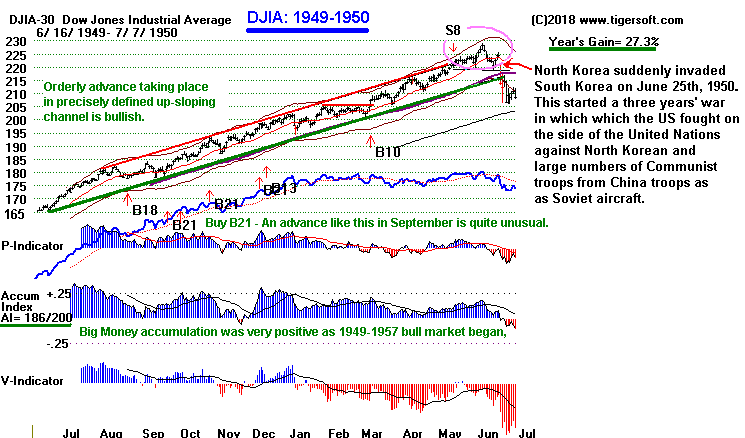
1950
Sept 12 - North Korean troops reach their farthest point of advance, the perimeter of the
port of Pusan. But its army's
strength has been nearly cut in half and it is almost entirely lacking in armor.
Sept 15 - UN forces achieve a sudden reversal
of fortunes with a massive amphibious counter-assault at Inchon. The bulk of the
North Korean army were destroyed
as UN troops moved into North Korea and in October approached the Yalu River and China.
It was at this time that
the Chinese People’s Volunteers Force troops crossed into North Korea and inflicted
serious losses on the lead units
of the UN advance and soon the main body of the U.N. forces were in full retreat. On
January 4th, Seoul is recaptured
by North Korea. Wall Street's response to the war became mostly technical by the end
of 1950. The DJI bounded
back and forth between the upper and lower band. There were no sell signas, only a
variety of Buy signals at the lower
band.
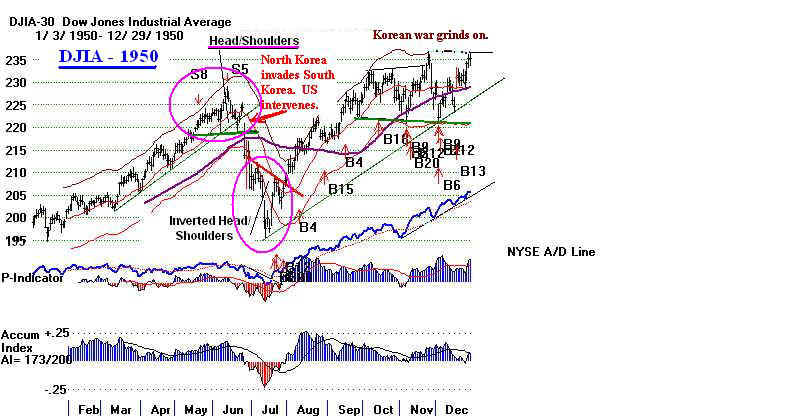
1950-1951
A batch of Peerless buy signals, reflecting bullish internal rstrength, brought a breakout
in the DJI as the new year started There was a brief pullback to 65-dma (purple) but it
stoped in May and the DJI made a June top which was signalled
by a Sell S9-v on April 30th. A head and shoulders (H/S) top began to appear,
but the neckline was not broken. In April
tensions in Washington D.C. became particularly frightening when a hero of the political
right, General Douglas Macarthur,
was fired for insubordination over his refusal to prosecute a limited war in Korea.
The General had used "extreme prejudice"
to break up the American veterans' Bonus Army in 1932 and was known for advocating a
policy of dropping nuclear weapons on North Korea and China in 1950 and 1951.
The DJI's broad (red-circled) Head/Shoulders (H/S) did not break down. Instead. it
turned up at the combined support
of its H/S "neckline" and the DJI's rising 200-day ma. General MacArthur
chose the "fade away" rather than fight. And
on July 10th a talks between the UN and Communist forces. This brought a
"relief: rally even though fighting continued
for two more years.
4/30/51 la/ma=1.024
V-I = -23
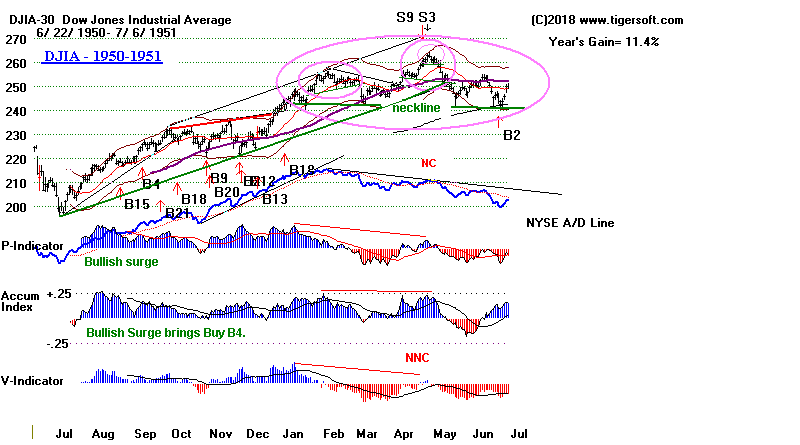
1951
Events
January 27 – Nuclear testing at the Nevada Test
Site begins with a 1-kiloton bomb dropped on Frenchman Flat,
northwest of Las Vegas.
March 14 – For the second time, United Nations troops recaptured Seoul.
March 29 - Ethel and Julius Rosenberg are
convicted of conspiracy to commit espionage. On April 5
they are
sentenced to receive the death penalty
March 31 – Remington Rand delivers the first UNIVAC I computer to
the United States Census Bureau.
April 7 - Operation Greenhouse: The first thermonuclear explosion is carried out on Enewetak Atoll
in the Marshall
Islands
of the Pacific by the U.S. Three more tests follow, the last taking place on
July 11–12 – Cicero race riot of 1951: A mob of 4,000 whites
attack an apartment building housing a single black
family in a neighborhood in Cicero, Illinois. As in 1919 and 1967, race riots
actually seem bullish to Wall Street.
September 8 - 48 nations sign a peace treaty with Japan to to formally end the Pacific
War.
- A Japan-U.S. Security Treaty is signed which lets American military forcs to be
stationed in Japan.
The NYSE A/D Line breaks its uptrendline and the DJI again falls back and finds support
at its rising 200-day ma
in November, a month that is often a good time to buy December usually advances.
Signals: B2 - Buy near lower 3.5% band below the red-21 day ma
S4 - Sell after a
10% rally when the Accumulation Index drops below its 21-dma
B17 - Buy on
weakness near the 3.5% lower band when the internal strength indicators are not falling.
B13 - Buy for a
Christmas rally after December 16 provided the DJI is not much above its 21-dma.
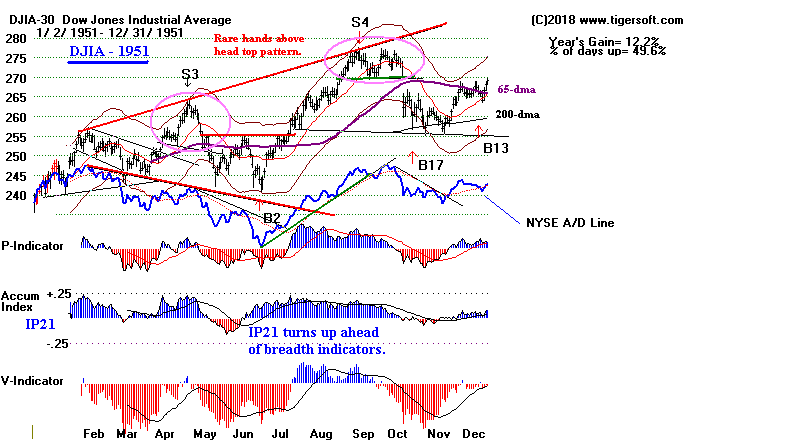
1951-1952
The chart below shows flat (red) resistance to have been tested 5-6 times,
depending on how perfectly
one wants the reach the resistance-line. The flat (green) support shows 5
successful test.
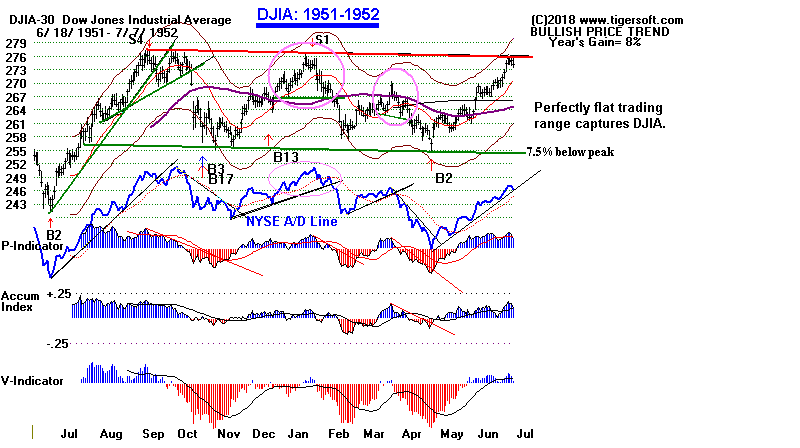
1952 Events
February 6 – In the United States, a mechanical heart is used for the first time in a human
patient.March 29 – U.S. President Harry S.
Truman announces that he will not seek reelection.
April 8 – Youngstown Sheet & Tube Co. v.
Sawyer: The U.S. Supreme Court limits the power of
the President to seize private business, after President Harry S. Truman nationalizes all
steel mills in the United States, just before the 1952
steel strike begins.
June 14 – The keel
is laid for the U.S. nuclear submarine USS
Nautilus.
July 19–26 – Washington D.C. UFO incident. Several
alleged UFOs
tracked on multiple radars. Jets scramble on several occasions and the objects take
evasive action, only to return after the jets leave the area.
September 2 – Dr. C. Walton Lillehei and Dr. F. John Lewis perform the first
open-heart surgery at the University o
November 1 – The United States successfully detonates
the first hydrogen bomb at Eniwetok
Atoll in the Marshall Islands
It has a yield of 10.4 megatons.
November 4 - Former General Dwight
D. Eisenhower and President of Columbia University wins the 1952 Presidential Election
in a landslide over Governor Adlai Stevenson. The Democrats wanted him for their
nomination.
November 29 – U.S. President-elect Dwight
D. Eisenhower fulfills a political campaign promise, by traveling to Korea
to find out what can be done to end the conflict.
Signals:
Buy B11 - The NYSE A/D Line
fails to confirm a minor DJI new low.
Sell S10 - Minor neckline
support is broken. The height of the H/S pattern sets up a minimum downside
targets that is is the height
of the pattern dropped down from the point of breakdowm.
Buy B4 - DJI rallies above
3.0% upper band with much improved internal strength.
Sell S16 - DJI rallies in
late December or early January on volume that is low considering the bullishness
of normal Santa Claus
rallies.
A rally leading into the
Presidential Election and afterwards is quite common. It gives expression to
the excessive exhurerance of
the partisans who have won the Presidential Election.
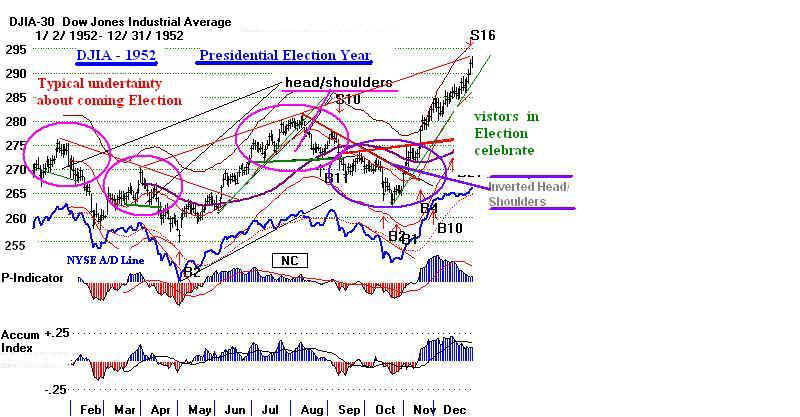
1952-1953
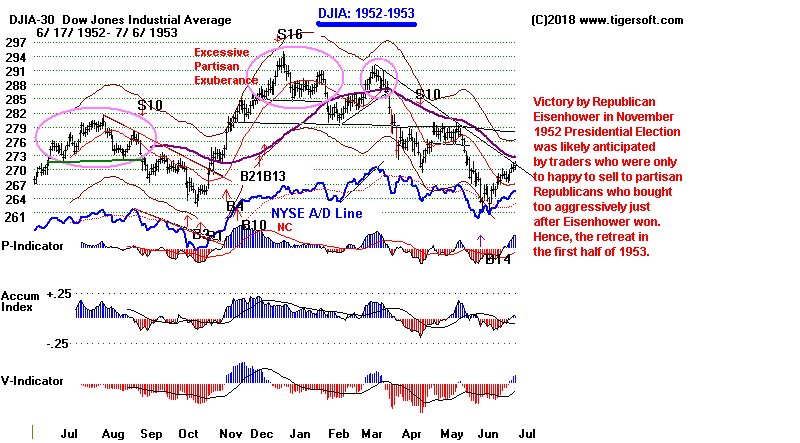
1953
Events
January 19 – Showing what sort of news/events dominated the attention of most
Americans in early 1953,
68% of all television
sets in the United States are tuned into I Love Lucy
to watch Lucille
Ball give birth.
What events took place at the market bottom in June and July 1953? Most important,
the Korean War ended its
fighting on July 27 and prisoners of war were repatriated in August. No formal peace
treaty was signed..
June 17 - Soviets crush protest by East German workers about 10% increase in production
quotas
which turn into demands for free elections. Soon afterward DJI rallies 4%.
June 19 – The U.S. executes Julius and Ethel Rosenberg for spying for the USSR.
June 30 – The first Chevrolet Corvette is built at Flint, Michigan.
July 28 – Burger
King opens its first restaurant in Jacksonville,
Florida.
August 5 – Operation Big Switch: U.S. prisoners of war are repatriated after the Korean War.
August 19 – In "Operation Ajax") – The CIA helped to
overthrow the democratic government of Mohammed Mossadegh
in Iran leaving Shah Mohammad
Reza Pahlavi on the throne to be ruler and despote. Mossadegh had made the
mistake
of nationalizing British Petroleum in Iran. Imperialistic interests on Wall Street
clearly dominated the CIA and
State Department under Eisenhower.
October 30 – In secret, President Eisenhower formally approved a top secret
NSC document (162/2)
stating that
United States' arsenal of nuclear weapons must be expanded to counter the commnist threat.
No Post-War Slump
The end of World War I and World War II brought significant sell-offs. Traders may
have expected one
after the end of the fighting in Korea. The DJI did pull-back a little, but Peerless
detected enough signs
of internal strength to give a series of Buys from June to December. Soon the
Eisenhower bull market
started. From the bottom at 257 in September 1953, the DJI raliied up to highs of
540 in 1956 and 1957.
Warren Buffet called this rise of more than 100% in the DJI, "the bull market that no
one remembers"
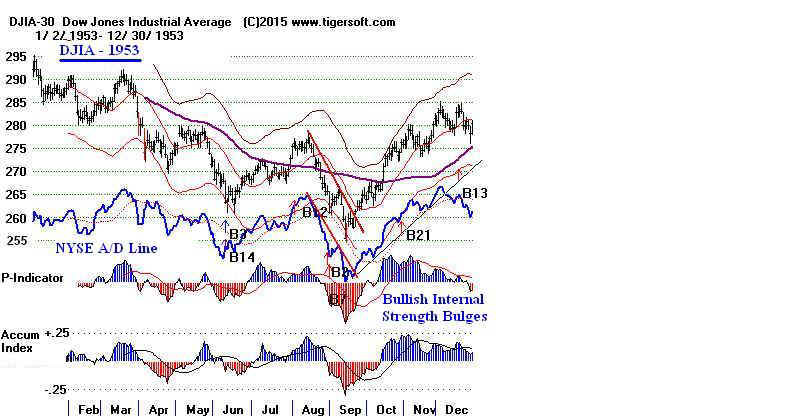
1953-1954
The FED Took Over The Wall Street Show.
Credit the Federal Reserve as much as anyone with the +100% Eisenhower Bull Market of
1953-1956. From February 1953 until January 1954, the Discount Rate had
been kept at a low rate of 2.0%. On February 1954, the FED dropped the Discount Rate
further to 1.79%. It did this as the DJI was making new all-time highs. This
is exactly reminiscent of what the FED did in mid-1927. In both cases, the result
was the same: a very strong advance. See in our chart below the five bullish
momentum signals at this time. See how the P-Indicator surged to a new high, as did
the A/D Line. Note also how our Accumulation Index rose into very positive territory
and stayed there until June. "Big money" was very bullish. The FED
then continued to provide "easy money" for the wealthy to play the market. It
lowered the discount rate to 1.75% in March, to 1,6% in Aoril and a easly 1.5% in May
1955. There it stood until April 1955 when they began slowlu rising it.
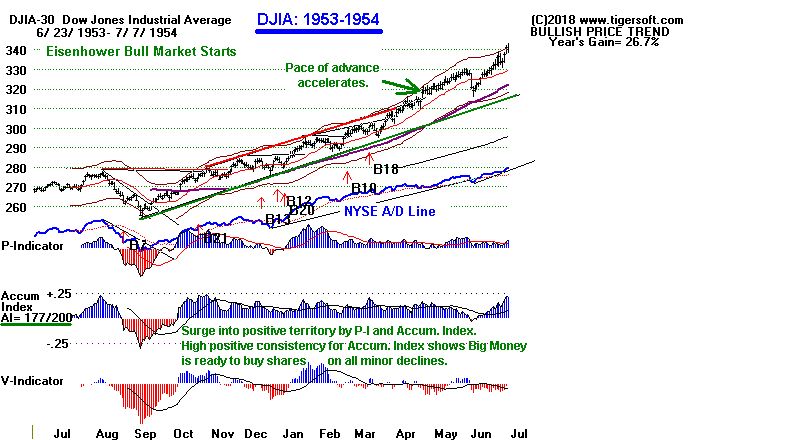
1954
January 25 – The foreign ministers of the United States, United Kingdom,
France and the Soviet Union
meet at the Berlin Conference.
February 10 – After authorizing $385,000,000 over the $400,000,000 already
budgeted for military aid to Vietnam, U.S. President Dwight Eisenhower warns against United States intervention
in Vietnam.
February 23 – The first mass vaccination of children against polio begins in Pittsburgh, Pennsylvania.
March 1 - U.S. officials announce that a hydrogen bomb test has been conducted on Bikini Atoll in
the Pacific
Ocean.
March 9 – Journalists Edward Murrow and Fred W.
Friendly produce a 30-minute See It Now documentary, entitled A Report on
Senator Joseph McCarthy.
April 1 – President Dwight D. Eisenhower authorizes the creation of the United States Air Force Academy in Colorado.
April 7 – Dwight D. Eisenhower gives his "domino theory"
speech during a news conference.
April 16 – Vice President Richard Nixon announces that the United States may be
"putting our own boys in Indochina regardless of Allied support."
April 22 – Senator Joseph
McCarthy begins hearings investigating the United
States Army for being "soft" on Communism.
May 7 - French lose a decisive 7 week battle with Viet Minh and their colonial grip over
S.E. Asia suffers a severe blow.
May 14 – The Boeing
707 is released after about two years of development.
May 16 – National Educational Television is launched on
cable TV. It will become PBS
on October 5 1970.
May 17 – Brown v. Board of Education (347 US 483 1954):
The United States Supreme Court
rules that segregated schools are unconstitutional..
June 17 – A CIA engineers a military coup occurs in Guatemala. June
27 – Guatemalan
President Jacobo Arbenz Guzmán steps down,
thus triggering a bloody civil war that continues for more than thirty-five years.
July 19 – Elvis Presley's first single, "That's All
Right", is released by Sun Records (recorded July 5 in Memphis,
Tennessee).
September 16 – Lewis Strauss, chairman of the United States Atomic Energy Commission,
in a speech to the National Association of Science Writers
claims: "It is not too much to expect that our children will enjoy in their homes
electrical
energy too cheap to meter".
October 18 – Texas Instruments announces the development of the first transistor
radio.
November 12 – The main immigration port of entry in New York
Harbor at Ellis
Island closes.
November 23 – The Dow Jones Industrial Average rises 3.27 points,
or 0.86%, closing at an all-time high of 382.74.
December 2 - The U.S. Senate votes 67–22 to condemn Joseph
McCarthy for "conduct that tends to bring the Senate
into dishonor and disrepute."
December 4 – The first branch of Burger King opens
in Miami.
December 23 – The first successful kidney transplant is performed by Joseph E. Murray, MD in Boston from one identical twin to his brother.
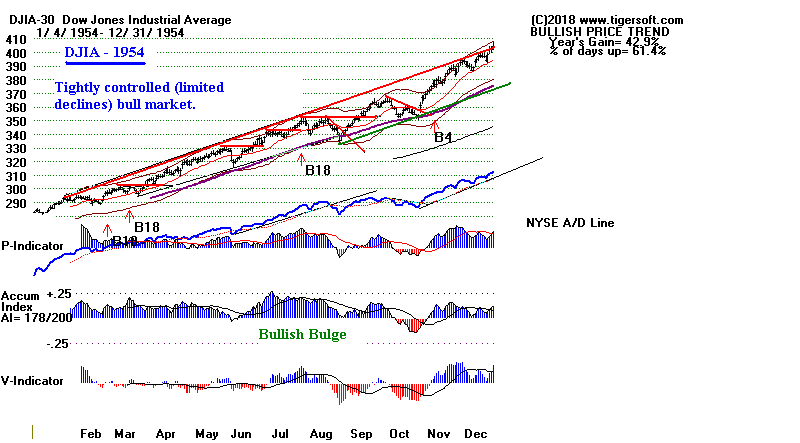
1954-1955

1955
January 22 – The Pentagon announces a plan to develop intercontinental ballistic missiles (ICBMs)
armed with nuclear weapons.
1956 Feb 14-25, Khrushchev denounced Stalin
at the 20th Communist Party Congress at Moscow.
February 10 – The Seventh Fleet of the United States Navy
helps the Republic of China evacuate Chinese Nationalist army and residents from the Tachen Islands to Taiwan.
February 12 – President Dwight D. Eisenhower sends the first U.S. advisors to
South Vietnam.
March 2 – Claudette Colvin, a fifteen-year-old African-American girl, refuses to give up her seat on a bus
in Montgomery, Alabama, to a white woman after the driver demands it. She is carried off
the bus backwards whilst being kicked and handcuffed and harassed on the way to the police
station. She becomes a plaintiff in Browder v.
Gayle (1956), which rules bus segregation to be unconstitutional.
March 5, The U.S. Supreme Court affirmed the ban on segregation in public schools in Brown
vs. Board of Education.
(HN, 3/5/01)
April 12 – Jonas
Salk's polio
vaccine, having passed large-scale trials earlier in the U.S., receives full approval
by the Food and Drug
Administration.
April 15 – Ray
Kroc opens his first McDonald's in Des
Plaines, Illinois.
July 17 - Disneyland
theme park opens in Anaheim, California, an event broadcast on the ABC television network.
July 18 – Illinois Governor William Stratton signs the Loyalty Oath Act, that mandates
all public employees take a
loyalty oath to the State of Illinois and the U.S. or lose their jobs.
July 18–23 – Geneva Summit between the U.S., Soviet Union, United
Kingdom and France.
September 24 – President Dwight
D. Eisenhower suffers a coronary thrombosis while on vacation in Denver.
December 1 – Rosa
Parks is arrested for refusing to surrender her seat on a bus to a white person in
Montgomery, AL
--The American Federation of Labor and the Congress of Industrial Organizations
merge to become the AFL-CIO
December 14 – Tappan Zee Bridge in New York
opens to traffic.
December 15 – Johnny Cash's "Folsom
Prison Blues" comes out.
General Motors becomes the first American
corporation to make over US$1 billion in a year.
Signals:
B19 is a two day reversal day after
a sell off to the lower band.
S9 - P-Indicator is almost negative
on a new high.
S7 - A/D NC on a new high.
S8 - A/D NC with DJI at upper band.
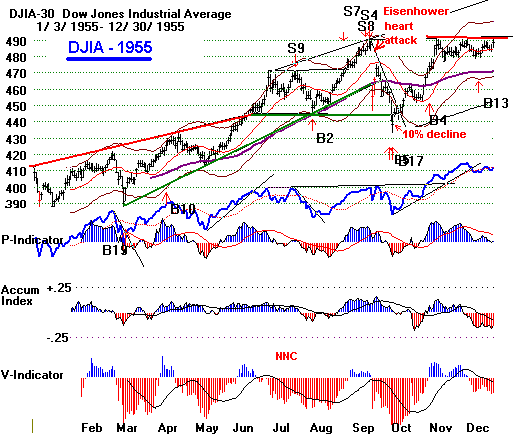
1955-1956
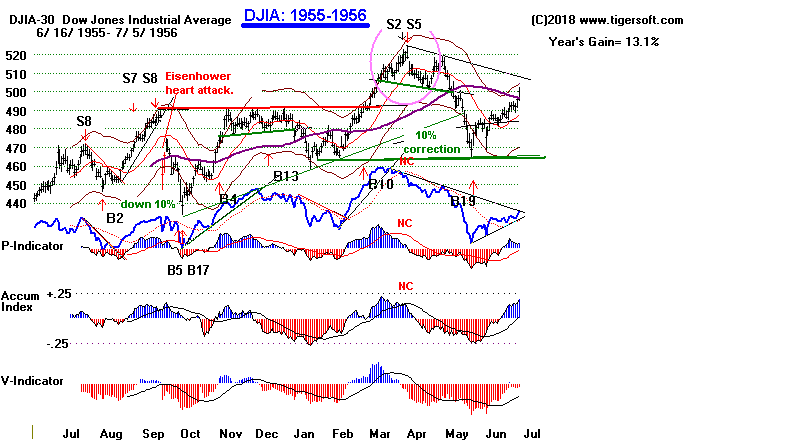
1956
February 14 – Dwight D. Eisenhower's doctors say that he is healthy
enough to seek another term at the White House.February 22 – Elvis Presley
enters the U.S. music charts for the first time with "Heartbreak
Hotel".
The Dow Jones Industrial Average closes above 500 for
the first time rising 2.40
points, or 0.48%, to 500.24.
Mar 5 - The U.S. Supreme Court affirmed the ban on segregation in public schools
in Brown vs. Board of Education.
Mar 10 - The Federal Hourly Minimum Wage was set at $1.00 an hour.
Mar 27 - US seized the US communist newspaper "Daily Worker."
Apr 18 - An Israeli-Egyptian cease fire, arranged by UN Gen’l. Sec. Dag
Hammarskjöld. , went into effect.
Apr 22 - Soviet authorities exposed a secret Allied spy tunnel built a year earlier
from Rudow in West Berlin to
Alt-Glienicke in East Berlin. It had tapped into underground cables and operated for 11
months and 11 days
intercepting Red Army communications.
Apr 23 - During a 10-day visit to England, Khrushchev announced that the USSR would
produce an H-bomb
guided missile.
Apr 28, Last French troops left Vietnam.
Apr 10, In Alabama singer Nat Cole was attacked on stage at the Birmingham Municipal
Auditorium by a small
group of white supremacists.
May 10, French government sent 50,000 reservists to Algeria.
June 4 – Montgomery bus boycott: Browder v.
Gayle is decided by the United States
District Court for the
Middle District of Alabama, ruling state bus segregation laws unconstitutional; this
will be confirmed on appeal.
June 28, 1956 - Polish workers began demonstrating for better working conditions. A
crowd of approximately
100,000 people gathered in the city centre near the local Ministry of Public Security building.
About 400 tanks
and 10,000 soldiers of the Polish People's Army and the Internal Security Corps under the command of the
Polish-Soviet general Stanislav Poplavsky were ordered to suppress the
demonstration and during the pacification fired at the protesting civilians. The death
toll is estimated from 57 to to over a hundred people. DJI continued to rally to
upper band.
https://en.wikipedia.org/wiki/Pozna%C5%84_protests_of_1956
June 29 - President Dwight D. Eisenhower signs the Federal Aid Highway Act creating the Interstate Highway System.
This is massive fiscal stimulus that will effect the lives of millions and also destroy
many small towns on the highways
that will be made obsolete.
July 4 – A U.S. Lockheed U-2 reconnaissance aircraft makes its first flight over
the Soviet Union.
July 26 -- Egyptian President Gamal Abdel Nasser announced the nationalization of the Suez
Canal Company,
the joint British-French enterprise which had owned and operated the Suez Canal since its
construction in 1869.
September 13 – The hard disk drive is invented by an IBM
September 27 – The Bell X-2 becomes the first manned aircraft to reach Mach 3
October 5 – Cecil B. DeMille's film The Ten Commandments, starring Charlton
Heston as Moses, is
released.
October 23 - Students in Hungary call for free elections, social democracy and the
neutralization of their country
in the Cold War along the lines of Austria. Those demands were taken up Imre Nagy,
the Hungarian Communist
Prime Minister. At first, the Soviet leadership decided not to intervene militarily,
but by November changed
their mind and a full-scale Soviet military invasion took place, thereby crushing the
Hungarian revolution between November
5th and the 10th.. Radio Free Europe had encouraged the rebellion, but the United
States chose not to intervene.
In the end the Hungarian Uprising has killed 2,500 Hungarians and 700 Soviet soldiers.
The DJI did not turn
around until the lower band was tested at the end of November.
https://en.wikipedia.org/wiki/Hungarian_Revolution_of_1956
On October 29, 1956, 10 Israeli brigades invaded Egypt and
advanced toward the canal, routing Egyptian forces..
The U.S., U.S.S.R and United Nations demand the French, British and Israeil troops to
leave. Israel did not win freedom
to use the canal, but it did regain shipping rights in the Straits of Tiran. Nasser
emerged from the Suez Crisis a victor and a hero for the cause of Arab and Egyptian
nationalism.
November 6 – 1956 United States presidential election:
Republican incumbent Dwight
D. Eisenhower defeats
Democratic challenger Adlai
E. Stevenson in a rematch of their contest four years earlier.
November 13 – Browder v. Gayle: The United States Supreme Court declares Alabama laws
requiring segregated buses illegal, thus ending the Montgomery
bus boycott.
1956 offer a Classic Presidential Election Trading Range
The 10% wide trading range of 1956 was whipped about by the broad divide between Whites
and Blacks in the U.S. over Civil Rights and the "Warren" Supreme Court.
Events in the Middle East were scary, too, even though Eisenhower and his Secretary of
State, Warren Dulles were determined not to engage the Soviet Union in a war of
proxies, as they termed the belligerents in the Middle East. But even more powerful
in determining the price swings on Wall Street was the Federal Reserve. It had
allowed the Discount Rate to stay below 2.5% until the end of 1954. But that keyt
rate rose to 2.5% in January 1956 and in April it was moved up to 2.65%. This sent
the DJI down sharply to its 10% down- from-the-peak
-level on May 28th, 1956 . By then, the Discount Rate had jumped again to 2.75%.
The second DJI peak in 1956 in August coincided with another boosting of the Discount
Rate, this time to 2.80% on
the way to 3% by the end of the year. Clearly, Wall Street listens and usually sells
when the FED raises rates. What
the FED gave the market in 1954, it begand taking away in 1956.
Why did the FED raise rates so fast in 1956? The CPI Inflation numbers did not
start rising in 1955 or even in
1956 until after they raised the Discount Rate. The FED simply were uncomfortable
with stocks having so quickly
doubled, we can guess.
Raw Index used in CPI
Calculations
1953-10-01
27.0
1955-07-01
26.8
1955-10-01
26.9
1956-04-01
26.9
1956-05-01
27.0
1956-06-01
27.2 Only in June 1956 did the CP make a new high.
1956-07-01
27.4
1956-08-01
27.3
1956-09-01
27.4
1956-10-01
27.5
1956-11-01
27.5
1956-12-01
27.6
Broad Trading Range
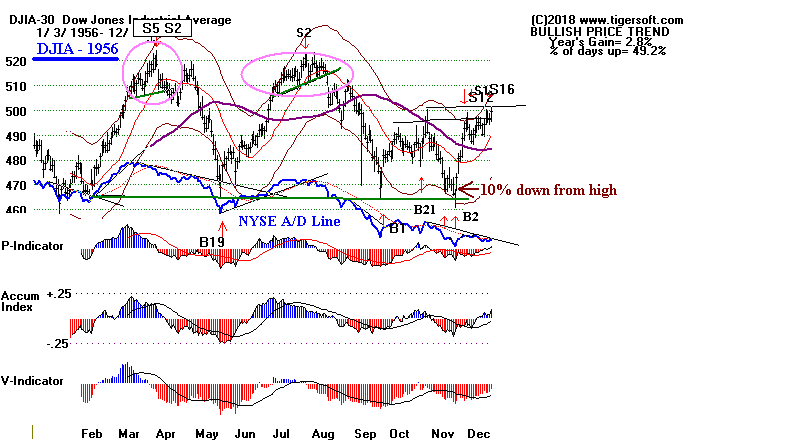
1956-1957
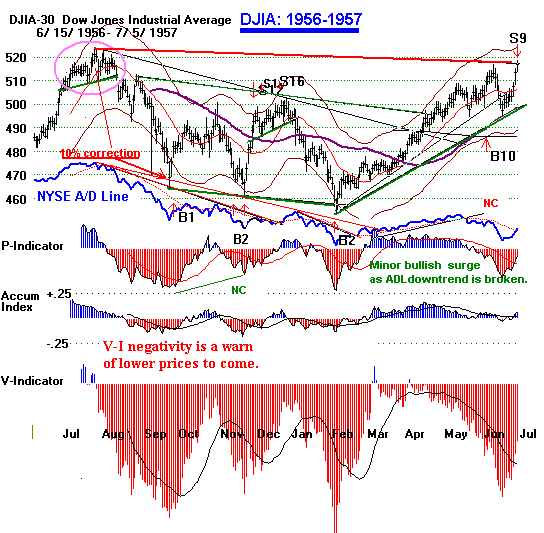
1957
Inflation and Interest Rates Bring The Bearish Top of July
1957
CPI Number Discount Rate DJIA
1957-01-01
27.6 3.0%
1957-02-01
27.7
1957-03-01
27.8
1957-04-01
27.9
1957-03-01
27.8
1957-04-01
27.9
1957-05-01
28.0
1957-06-01
28.1
1957-07-01
28.3 At this
point traders expect a rise in the Discount Rate.
1957-08-01
28.3 3.15%
1957-09-01
28.3 3.5%
1957-10-01
28.3
1957-11-01
28.4 3.23%
1957-12-01
28.4 3.0%
1958-01-01
28.6 2.94%
1958-02-01
28.6 2.75%
January 23 – Ku Klux Klan members force truck driver Willie Edwards to jump off a bridge into the Alabama River;
he drowns as a result.
March 7 – The United States Congress approves the Eisenhower
Doctrine.
March 13 – The U.S. Federal Bureau of Investigation arrests Jimmy Hoffa and
charges him with bribery.May
3 – Brooklyn Dodgers owner Walter
O'Malley agrees to move the team from Brooklyn, to Los Angeles.
July 16 – United States Marine Major John Glenn flies an
F8U supersonic jet from California to New York
in 3 hours, 23 minutes and 8 seconds, setting a new transcontinental speed record.
September 4 - American Civil Rights Movement
– Governor Orville Faubus of Arkansas calls out the National Guard of the
United States to prevent the "Little Rock
Nine" African American students from enrolling in Little Rock Central High School.
September 24 – U.S. President Dwight
D. Eisenhower sends federal troops to Arkansas to provide safe passage into Little Rock Central High School for the Little Rock
Nine.
October 10 - President Dwight D. Eisenhower apologizes to the finance minister
of Ghana, Komla Agbeli Gbdemah, after he is refused service in a
restaurant in Dover, Delaware.
October 11 – The orbit of the last stage of the R-7 Semyorka
rocket (carrying Sputnik I) is first successfully calculated on an IBM 704 computer during Operation
Moonwatch, Cambridge, Massachusetts.
October 21 – The U.S. military sustains its first combat fatality in Vietnam, Army Capt. Hank
Cramer of the 1st Special Forces Group.
November 1 – The Mackinac Bridge, the world's longest suspension
bridge between anchorages at the time, opens to
traffic connecting Michigan's
two peninsulas.
November 7 – The Gaither Report calls for more American missiles and fallout
shelters.
November 14 – Apalachin Meeting: American Mafia
leaders meet in Apalachin, New York, at the house of Joseph Barbara; the meeting is broken up by a curious
patrolman.
December 20 – The Boeing 707 airliner flies for the first time.
7/8/1957
Major S9 - Negative Non-Confirmation by P-Indicator and V-I of new highs,
la/ma = 1.022, P-I = -27, V-I = -188 (very heavy big money selling)
The 520-peak was reached twice in 1956. This reinforces the number
as a key resistance level.
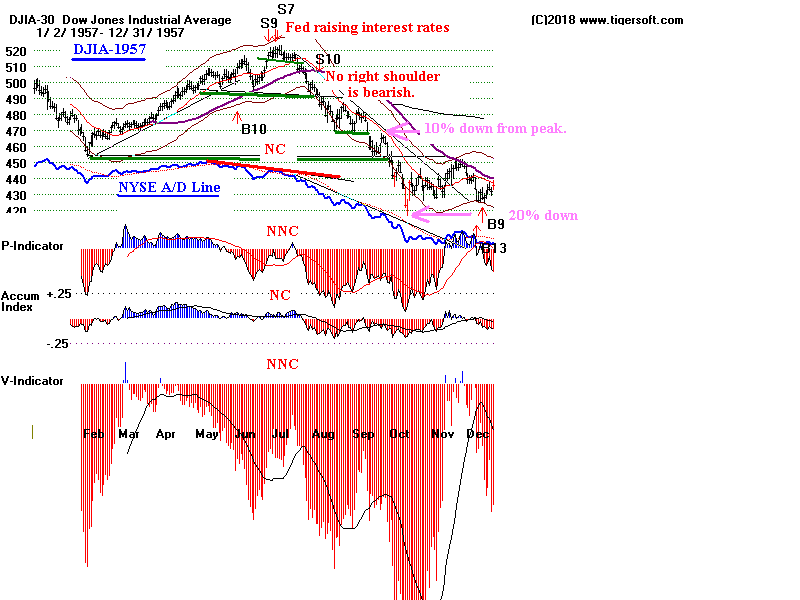
1957-1958
10/22 Bottom - exactly 20% down from peak
B9 on the next test of lows - DJI tagged the lower band with the P-I positive.
The 1957-1958 bottom is no completed until the well-tested (red) resistance
is closed decisively above. That is what the Buy B4 shows May 2nd
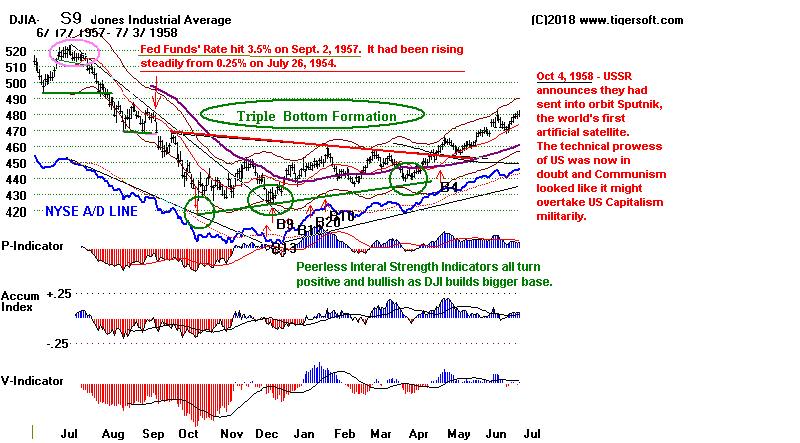
1958
January 13 – In One, Inc. v. Olesen, the Supreme Court affirms that homosexual
writing is not per se obscene.February 5 – The Tybee
Bomb, a 7,600 pound (3,500 kg) Mark 15 hydrogen bomb, is lost in the waters off
Savannah, Georgia.
March 11 – 1958 Mars Bluff B-47 nuclear
weapon loss incident: A U.S. B-47 bomber accidentally drops an atom
bomb on Mars Bluff, South Carolina. Its conventional explosives destroy a house and
injure several people, but no nuclear fission occurs.
April – Unemployment in Detroit reaches 20%, marking the height of the Recession
of 1958 in the United States.
May 9 – Actor-singer Paul Robeson, whose passport has been reinstated, sings in a
sold-out one-man recital at Carnegie Hall.
May 13 – During a visit to Caracas, Venezuela, Vice President Richard M. Nixon's car is attacked by anti-American
demonstrators.
July 7 – President Dwight
D. Eisenhower signs the Alaska
Statehood Act into United States law.
July 15 – During the 1958 Lebanon crisis, 5,000 United States Marines land in the capital Beirut in order to protect
the pro-Western government there.
August 27 – Operation Argus: The United States begins nuclear tests over
the South Atlantic.
September – The University of New Orleans begins classes as the
first racially integrated public university in the South.
Signals:
Buy B4 - Breakout and bulging P-I and Accum. Index.
Buy B21 and B18 signify momentum is very bullish.
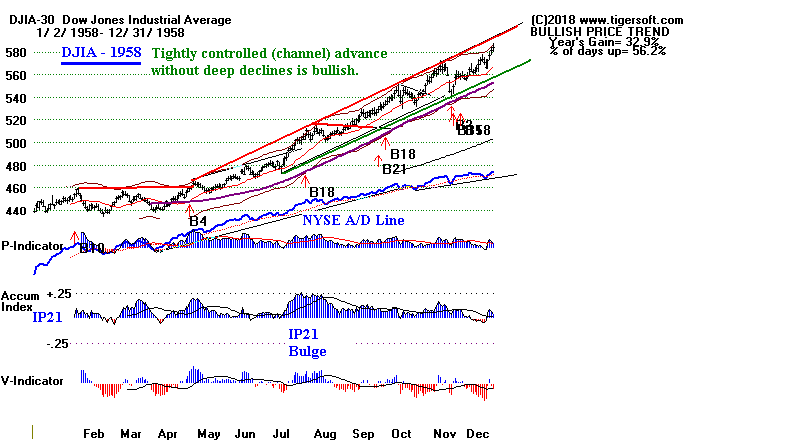
1958-1959
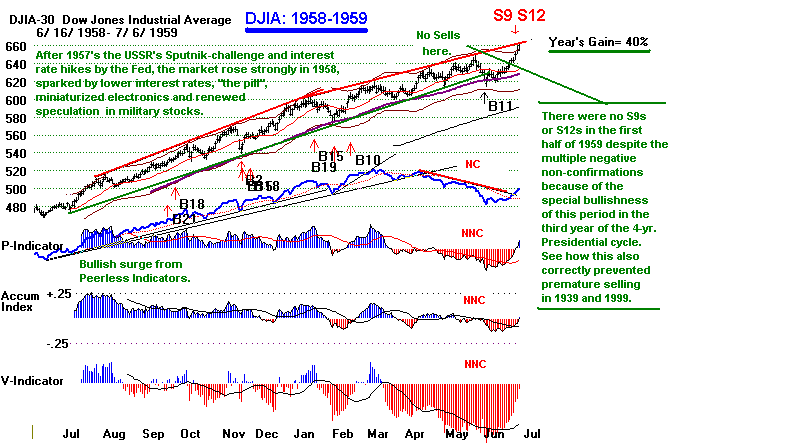
1959
January 7 – The United States recognizes the new Cuban government of Fidel Castro.February
6 – At Cape
Canaveral, Florida,
the first successful test firing of a Titan
intercontinental ballistic missile is accomplished.
July 8 – Charles Ovnand and Dale R. Buis
become the first Americans killed in action in Vietnam.
July 15 – Steel strike of 1959: Labor union strike in the U.S.
steel industry.
July 24 -- At the opening of the American National Exhibition in Moscow, U.S. Vice President
Richard Nixon
and USSR Premier Nikita Khrushchev have a "kitchen debate."
December 1 – Cold
War – Antarctic Treaty: 12 countries, including
the United States and the Soviet Union, sign a landmark treaty, which sets aside Antarctica as a
scientific preserve and bans military activity on that continent (the first arms control
agreement established during the Cold War).
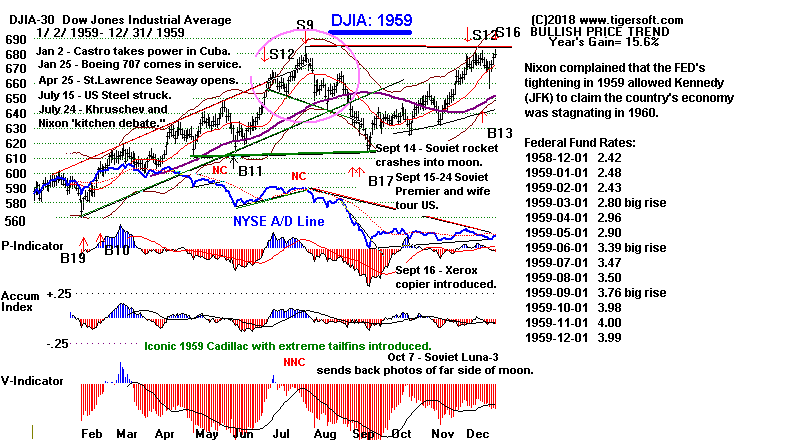
The Cold War brought
special opportunities for investors. See how well Thoikol held up in the 1957
bear market. When
the bear market was over in October 1957, it was the one of the "first out of the
gate"
and rapidly rose from
10 to 70 at the end of the decade.
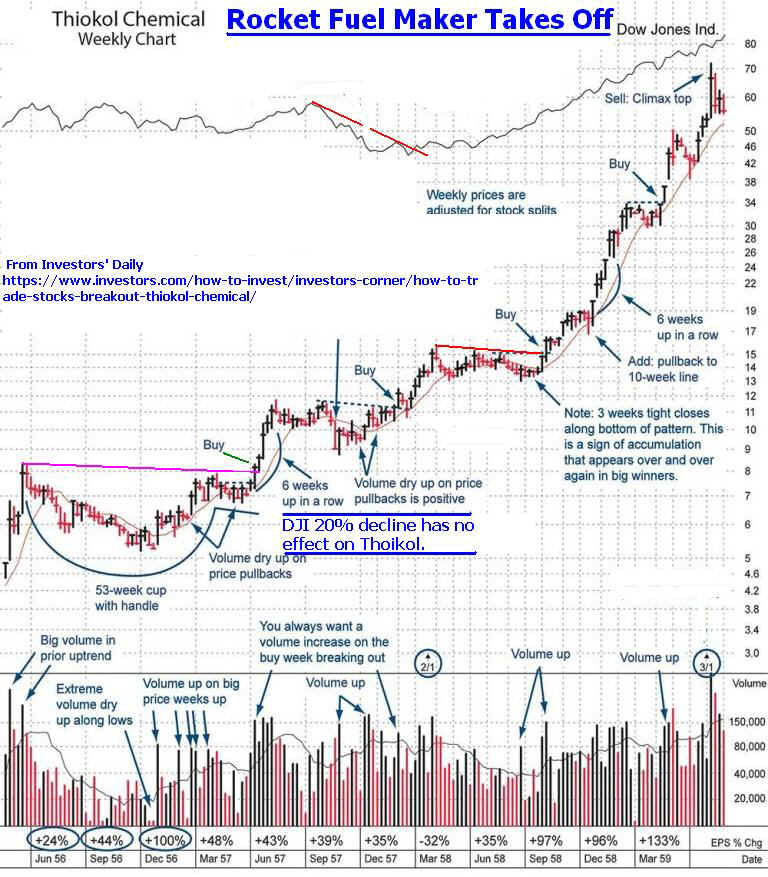
====================================================================================
=======================================
<1>
Price Index used for CPI
--------------------------
1949-12-01
23.6
1950-01-01 23.5
1950-02-01 23.5
1950-03-01 23.6
1950-04-01 23.6
1950-05-01 23.7
1950-06-01 23.8
1950-07-01 24.1 Korean War starts
1950-08-01 24.3
1950-09-01 24.4
1950-10-01 24.6
1950-11-01 24.7
1950-12-01 25.0
1951-01-01 25.4
1951-02-01 25.7
1951-03-01 25.8
1951-04-01 25.8
1951-05-01 25.9
1951-06-01 ,25.9
1951-07-01 25.9
1951-08-01 25.9
1951-09-01 26.1
1951-10-01 26.2
1951-11-01 26.4
1951-12-01 26.5
1952-01-01 26.5
1952-02-01 26.3
1952-03-01 26.3
1952-04-01 26.4
1952-05-01 26.4
1952-06-01 26.5
1952-07-01 26.7 Peak of war-time inflation
1953-06-01, 26.8
1953-08-01, 26.9
1953-10-01, 27.0 Peak of inflation until 1956
<2>
https://en.wikipedia.org/wiki/Impact_of_the_Korean_War_on_the_economy_of_the_United_States


